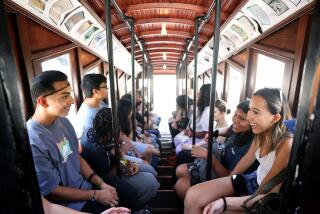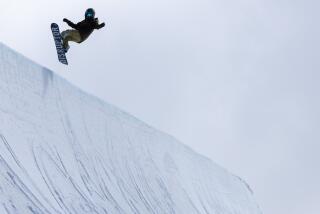Boarding school, minus trust funds
- Share via
On the road to Running Springs — A bus climbs through the San Bernardino Mountains. On board, a hesitant and unlikely team of heroes has set off on a journey through strange territory. It requires courage and persistence, but in the end, a family is reassembled and just about everybody winds up happy and wet.
That’s “Finding Nemo,” now beaming and blaring from a pair of mounted monitors behind the driver. But in the faces along the aisle of this bus, there’s another story. These three-dozen inner-city kids, ages 10 to 18, are headed east for a day of snowboarding, and this is not normal.
Snowboarding isn’t exactly a dominant sport among students at South Gate High School, Bell High School or 93rd Street Elementary School. Nor is it particularly big among the kids in group homes and foster programs run by the Los Angeles County Department of Children and Family Services.
Most of these kids were recruited from low-income neighborhoods through those sources and a handful of others. Some struggle with school, some with drugs and alcohol, and plenty endure amid family arrangements more fraught and complex than anything Nemo’s animators are likely to dream up. In too many of their families, reassembly is not an option.
At the moment, however, they’re chattering and peering out as the bus threads its way through the fire-scarred foothills. John, a tiny, doe-eyed 11-year-old fifth-grader at 107th Street Elementary School in Los Angeles, sits in the front row, quietly attacking a bag of potato chips. He’d never seen snow until two weeks ago, when this program first brought him this way.
“It’s gonna be cold on the mountain,” he says, staring into the thickening mist. “It’s all fogged up.”
This program is called Chill. It was created in 1995 by the Burlington, Vt.-based snowboarding equipment maker Burton and has expanded to nine cities in the U.S. and Canada, with Burton covering about a third of Chill’s $350,000 annual budget. About 185 kids in Los Angeles will be carted to the snow this winter in the program, which arrived here in 2000. Mitsubishi Motors picks up the local tab.
In every city, Chill hires a few staffers, enlists a resort, lends boots, boards, goggles and such. On a schedule timed to match breaks in the multitrack school calendars, the kids take weekly day trips for six weeks. This is Week 3, and the theme is “respect.” (During the first two weeks, when newbie snowboarders spend a lot of time sprawled on their bellies or fannies, the words of the day were “patience” and “persistence.”)
Now we’re nearly there. Chill’s lead site coordinator, Alex Kim, a 25-year-old student of Spanish literature and culture at UC Irvine, works the microphone. Why, he asks, do you think we should be respectful?
“So they won’t call our parents,” says Martin Guzman, an 18-year-old senior at South Gate High School.
“So you won’t get an F,” says little John in front.
OK, says Kim, but think about the respect everybody deserves, “not because of the position they’re in, but because they’re a person. Because you want to be respected too.”
When the bus pulls into the Snow Valley Mountain Resort, the troops and chaperons head inside for outfitting, then out to lessons and the slopes. It’s Tuesday, so the mountain is theirs.
Unfortunately, John’s forecast is dead-on. Thick fog sits upon the bunny slope, leaving many boarders with just 30 to 50 feet of visibility. Careening through, you get battlefield glimpses: bodies in motion, bodies splayed in the snow. But there’s progress. A dozen kids graduate from lessons and are let loose on some lifts, in pairs, without instructors.
Martin and his friend Jose Villa, 17, quick learners who are among the best snowboarders on the bus, tutor a latecomer to the program.
“Your toes ... “ says Martin as the latecomer takes a bounce on his chest.
“Your heels ... “ says Jose, as the latecomer’s legs shoot from beneath him and he crash-lands on his coccyx.
Yeah, yeah, that was me. But the tale told by Javier Gonzalez, a 15-year-old 10th-grader at Bell, gives me hope. On his first trip, “it was scary and I fell a lot,” he says. On the second, “it was easier, but I still had some fear.”
And now, heading back to return his equipment, he wears the grin of a happy warrior. No fear of falling this time, just “fear of going too fast.”
Of course, these mountain days are a rehearsal for the world at large: You struggle, you fall, you fall again, it hurts, and maybe you quit or just go through the motions. Lots of kids know this much already. But up here, if you stick it out, find balance, build momentum, you eventually control your direction. And even if the kids only cover a little ground on the slope, some come away befriended, uplifted.
“To see those tough exteriors sort of melt away, when they get on the snow, is an amazing thing,” says Maggie Harper, Seattle-based national coordinator of the program.
But things do go wrong on the mountain, the same way they do on the street. Doe-eyed John falls hard, suffers a mild concussion and is transported to the local hospital, where his family picks him up. Until now, nobody this season has needed a hospital. On the bus ride back down the hill, Kim will mention the injury and warn the troops to heed their instructors and respect the slope.
But in the moments before departure, it’s clear that most of the kids are in no hurry. Newfound buddies Tyree Pettway, a 10-year-old from Los Angeles, and Teri Ingram, an 11-year-old from Fontana, drift into view through the mist, dragging their boards. They look utterly done, until an idea occurs to Teri.
“Snow angels!” she hollers, and in a flash, the girls have cast their boards aside and flung themselves down to flap in the slush. Never mind what waits at the bottom of the mountain: These are kids in flight.
To e-mail Christopher Reynolds or to read his previous Wild West columns, go to latimes.com/chrisreynolds.



